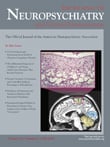REGULARFull Access
Published Online:1 Oct 2008
- Cited by
- 5 June 2021 | Human Brain Mapping, Vol. 42, No. 12
- 24 March 2016 | Brain Imaging and Behavior, Vol. 11, No. 3
- 18 September 2015 | International Journal of STD & AIDS, Vol. 27, No. 11
- 6 January 2015 | Clinical EEG and Neuroscience, Vol. 47, No. 2
- Cardiovascular Psychiatry and Neurology, Vol. 2011
Metrics
History
Published online 1 October 2008
Published in print 1 October 2008



